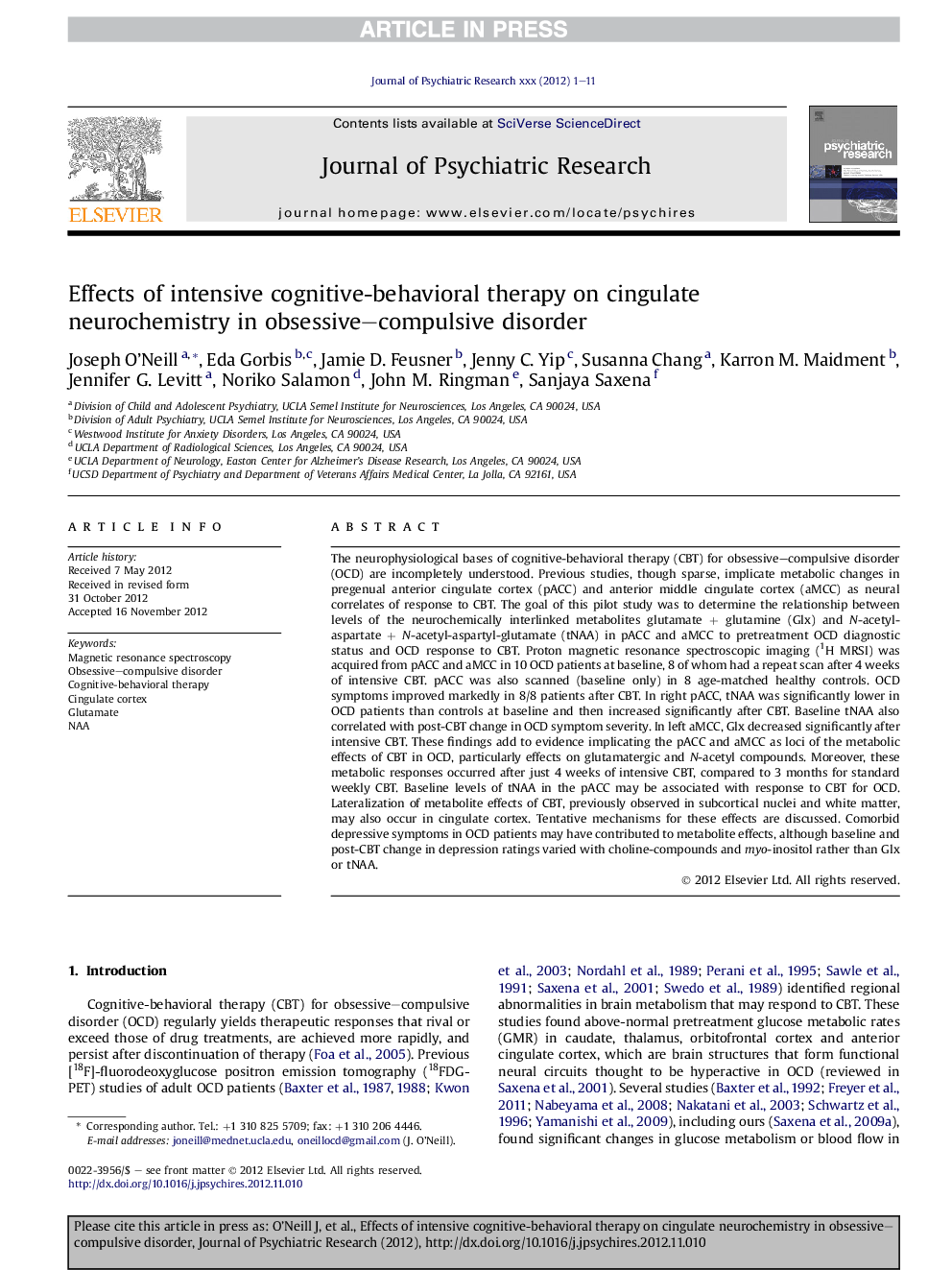| کد مقاله | کد نشریه | سال انتشار | مقاله انگلیسی | نسخه تمام متن |
|---|---|---|---|---|
| 10302273 | 542714 | 2013 | 11 صفحه PDF | دانلود رایگان |
عنوان انگلیسی مقاله ISI
Effects of intensive cognitive-behavioral therapy on cingulate neurochemistry in obsessive-compulsive disorder
ترجمه فارسی عنوان
اثرات درمان شناختی-رفتاری شدید بر روی نوروشیای سینگولت در اختلال وسواسی-اجباری
دانلود مقاله + سفارش ترجمه
دانلود مقاله ISI انگلیسی
رایگان برای ایرانیان
کلمات کلیدی
موضوعات مرتبط
علوم زیستی و بیوفناوری
علم عصب شناسی
روانپزشکی بیولوژیکی
چکیده انگلیسی
The neurophysiological bases of cognitive-behavioral therapy (CBT) for obsessive-compulsive disorder (OCD) are incompletely understood. Previous studies, though sparse, implicate metabolic changes in pregenual anterior cingulate cortex (pACC) and anterior middle cingulate cortex (aMCC) as neural correlates of response to CBT. The goal of this pilot study was to determine the relationship between levels of the neurochemically interlinked metabolites glutamate + glutamine (Glx) and N-acetyl-aspartate + N-acetyl-aspartyl-glutamate (tNAA) in pACC and aMCC to pretreatment OCD diagnostic status and OCD response to CBT. Proton magnetic resonance spectroscopic imaging (1H MRSI) was acquired from pACC and aMCC in 10 OCD patients at baseline, 8 of whom had a repeat scan after 4 weeks of intensive CBT. pACC was also scanned (baseline only) in 8 age-matched healthy controls. OCD symptoms improved markedly in 8/8 patients after CBT. In right pACC, tNAA was significantly lower in OCD patients than controls at baseline and then increased significantly after CBT. Baseline tNAA also correlated with post-CBT change in OCD symptom severity. In left aMCC, Glx decreased significantly after intensive CBT. These findings add to evidence implicating the pACC and aMCC as loci of the metabolic effects of CBT in OCD, particularly effects on glutamatergic and N-acetyl compounds. Moreover, these metabolic responses occurred after just 4 weeks of intensive CBT, compared to 3 months for standard weekly CBT. Baseline levels of tNAA in the pACC may be associated with response to CBT for OCD. Lateralization of metabolite effects of CBT, previously observed in subcortical nuclei and white matter, may also occur in cingulate cortex. Tentative mechanisms for these effects are discussed. Comorbid depressive symptoms in OCD patients may have contributed to metabolite effects, although baseline and post-CBT change in depression ratings varied with choline-compounds and myo-inositol rather than Glx or tNAA.
ناشر
Database: Elsevier - ScienceDirect (ساینس دایرکت)
Journal: Journal of Psychiatric Research - Volume 47, Issue 4, April 2013, Pages 494-504
Journal: Journal of Psychiatric Research - Volume 47, Issue 4, April 2013, Pages 494-504
نویسندگان
Joseph O'Neill, Eda Gorbis, Jamie D. Feusner, Jenny C. Yip, Susanna Chang, Karron M. Maidment, Jennifer G. Levitt, Noriko Salamon, John M. Ringman, Sanjaya Saxena,
